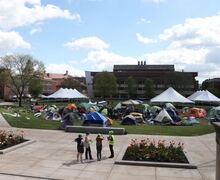SU project combines science and art to create lava fields
Courtesy of Noah Hausknecht
The SU Lava project team pours molten lava onto ice. The lava is more than 2000 degrees Fahrenheit.
This isn’t your fifth grade science project volcano.
It’s 800 pounds of lava, more than 2,000 degrees Fahrenheit, made in a furnace and poured out from a container the size of a small bathtub.
The Syracuse University lava project, which started in 2010, creates lava in the Comstock Art Facility by melting dresser trap rocks that are more than a billion years old, said the project’s artist and co-creator, Bob Wysocki.
On Monday morning, Wysocki and Jeff Karson, an earth sciences professor and co-creator of the project, poured out lava onto a mixture of ice and snow near the arts facility, both as an experiment for researchers from Dickinson College and for a filming demonstration for the Weather Channel.
“When we pour it on the ice, it’s spectacular. The lava is over 1,000 degrees centigrade, while the ice is zero degrees,” Karson said. “It makes steam, and as it expands, it does natural glass-blowing and creates these natural clear bubbles of lava, sometimes the size of a softball or a basketball.”
Institutions such as Columbia University, Brown University and NASA have contacted the lava projects at SU and Dickinson, Wysocki said.
Wysocki added that the lava created at SU has the same attributes and behaviors of lava found from volcanoes, a major benefit for those interested in studying the molten material.
“What we’re able to do, it’s highly controlled. Whereas you go to Iceland or you go some place where there’s an active volcano, there’s just too many variables,” Wysocki said.
This is the closest a Central New Yorker will get to authentic lava, without traveling to a real, live volcano.
“There’s no place else in the world anyone is pouring lava on this scale. This is absolutely a unique thing for Syracuse,” Karson said. “They have an opportunity to see something you’d normally have to go to Hawaii or Iceland to see. We’re bringing a volcano to Central New York.”
The lava-creating process takes a few hundred pounds of rocks, which takes 24 hours to melt into 800 pounds of lava, Wysocki said. For the demonstration on Monday morning, Wysocki stayed up the entire night before, stirring the lava inside the $2,500 bronze furnace every 20 to 30 minutes. He had only slept for a few hours because he was busy maintaining the lava furnace.
Karson said the project is a strong mixture of both the sciences and the arts, between himself and Wysocki, who is also a professor at SU. Karson added that even though his main focus on the project is on the science angle, the beauty behind the bright glowing lava at 1,000 degrees Fahrenheit always strikes him.
Wysocki added that lava’s nature was usually very appealing, regardless of who the audience was.
“Everyone has a sense of lava,” he said. “My five-year-old pre-K son, as well as a post-doctoral student, I think when the lava first pours out, have a very similar experience. As does my 83-year-old mother.”
Wysocki said even though he was on the artistic end of the project, he wanted the lava to be as realistic as possible. He added that he wanted it to resemble a lava field, so that scientists would be able to use his art for research. His goal is to create lava fields in places they don’t belong, such as inside a museum or in a park.
Noah Hausknecht, a research assistant on the project, said at first the project seemed to be more scientific than artistic, but the accuracy of the lava is what makes it art.
Wysocki added that this work is the first of its kind, saying that there’s no prior literature on creating lava fields on this scale.
The project is setting a new precedent in the science field, said Hausknecht a senior sculpture major. He said the lava project is becoming the piece of work that every scientist will be citing.
“Just from doing all these experiments, it’s naturally changed everyone’s thought process,” he said. “Everyone’s understanding of the object itself, that they’re both somewhat one in the same.”
The creators are currently applying for National Science Foundation grants, and hope to expand the project even further with the potential funds.
The team is looking to have a furnace that’ll be able to create 5,000 pounds of lava per hour, and create an exhibit that people would be able to interact with and walk on, Hausknecht said.
Published on January 22, 2014 at 9:50 pm
Contact Alfred: [email protected]
@alfredwkng




